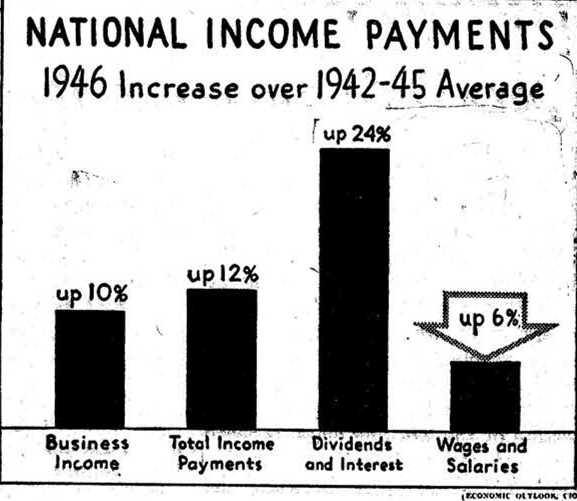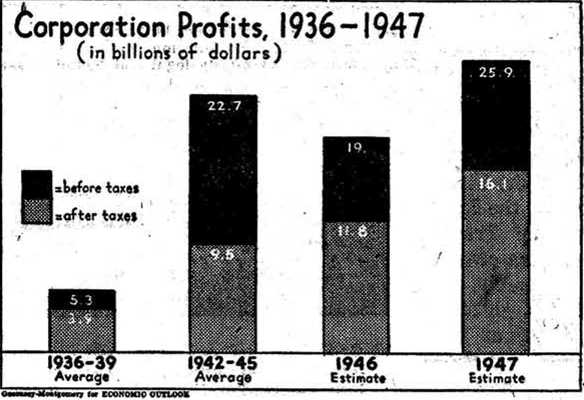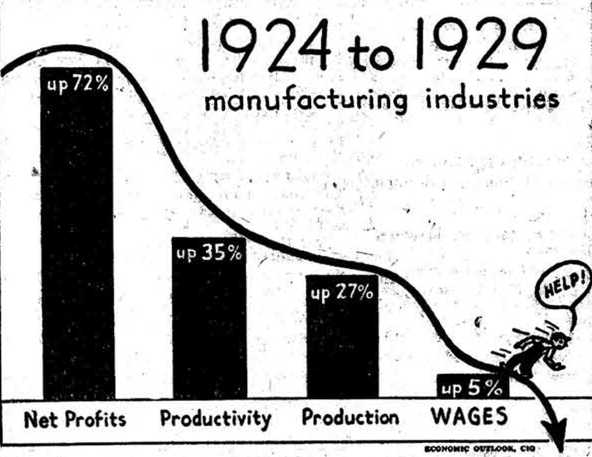
Glotzer Archive | Trotskyist Writers Index | ETOL Main Page
From Labor Action, Vol. 10 No. 50, 16 December 1946, pp. 3 & 6.
Transcribed & marked up by Einde O’Callaghan for ETOL.
IS THE American economy in a state of collapse? Have profits dwindled to the vanishing point? Are the workers making too much money? Do we now live in a state of economic chaos?
If one were to accept as gospel what the big business men say and what their press writes, or take seriously the mutterings of the less-than-learned politicians in Washington, the answer to the above questions would be “Yes.”
All the propaganda which gushes forth from these quarters in endless quantity has a simple purpose: to forestall and reject the just wage demands of the union movement. The old chestnut about the necessity of increasing productivity before wages can be hiked upwards is only another way the capitalists have of saying no to the wage earners.
The truth about the economic situation in the country is in complete conflict with the propaganda of big business. The latest report of the CIO in Economic Outlook bears out what Labor Action has been saying for a long time:
Pre-war standards of production, wages and profits, were broken swiftly by gains which began shortly before the war broke out in Europe and extended throughout the war years into the reconversion period. The real picture of the economic situation shows that big business is making greater profits than ever before, based on the highest level of peacetime production yet experienced. In contrast, the share of the wage earner in the national income declined at the same time that the cost of living has soared to new heights.
The graphs which accompany this article illustrate the precise relationship which exists between the owners of industry and the workers who produce the goods of life. But there is a section of the whole picture which they do not show: bonuses, special expenses, and high salaries, that go to the big businessmen and which are not counted in the profits. There is also a degree of distortion in the graphs which depict national income, for they include both wages and low salaries along with profits, dividends, etc. In the latter are included the incomes of company officials and their immediate subordinates who do not fall into the category of wage earners. Bearing such factors in mind we are in a position to describe the relationships between the classes in this country which grow out of the capitalist social organization divided between those who own the means of life and those who produce the means of life.
We will begin with profits first, not only because this is the best indicator of the state of things, but also because it is on this score that the profiteers wail the loudest. What they describe as a calamitous situation for the owners of capital is really a cover for the monstrous profits they have made during the war and are making now.
Profits before taxes are collected show a rise from $5.3 billion in the 1936–39 period to $25.9 billion estimated for 1947. These profits before taxes merely show the huge portion of production which goes exclusively to the parasitic class in capitalism. But in case the interjection is made that the capitalists pay high taxes we present the figures of profits after taxes have been paid to show that they are just as exorbitant:
|
All Corporations¹ |
|
1936–39 – $3.9 Billions |
|
1942–45 – $9.5 Billions |
|
1946 – $11.8 Billions (estimated)² |
|
1947 – $16.1 Billions (estimated)³ |
|
¹ Source: Dept, of Commerce. |
The two figures described as estimates are based on figures for the greater part of 1946, as well as trends in production and employment which are indicated for the year 1947. It is true that the figures, as Economic Outlook points out, “fluctuate from industry to industry.” Some may not profit as high as others because of material shortages, or production bottlenecks for which they are themselves responsible. In the auto and electrical industries, for example, the manufacturers have themselves created conditions by their bungling management to prevent full production. But industry as a whole, especially those sections which overcame or had no reconversion problems, are enjoying “terrifically high profit returns in 1946.”
Two important facts contributed to these high profits and for both of them industry must thank its servants in Congress. First, excess profits taxes were eliminated on January 1, 1946. Corporations which had until then paid a maximum tax of 85 per cent on all income in excess of exemptions, now pay 38 per cent. They all received a five per cent reduction on their normal tax. Second, congressional assistance in the form of mutilating and finally ending all price controls enabled big business to pass on whatever wage increases were granted to the public and in general increased profits through the rise in prices.
Thus, Economic Outlook summarizes the profit situation saying:
“The estimated 1946 profits are 200 per cent higher than average profits in 1936–39 and about 25 per cent higher than the 1942–45 average of $9.5 billions.
“In all manufacturing corporations,1946 profits, after taxes, will be $7 billion, or $2 billion higher than the 1942–45 average, and $4.5 billion higher than the 1936–39 average.”
What else could John E. Steelman, Director of the Office of Economic Stabilization, say in knowledge of the above facts except that “business profits, after taxes, are at their highest point in history.”
But at the same time that profits soar to new high levels, the workers share of the total national income has declined. In 1936–39 wage and low-salary earners received 63.5 per cent of the national income (wages, salaries, business incomes, rents, royalties, dividends and interest).

|

|
As a result of a redistribution of national income in favor of profits, dividends, and interest, the actual share of the wage earners and low salaried employees rose during the war years to 67.7 per cent and since the war’s end declined to 62.6, below the average of the years 1936–39.
Put in another way: total income payments (Wages, salaries, profits, rents, royalties, dividends and interest) rose 12 per cent during 1942–45 and the first eight months of 1946, wages and salaries advanced only six per cent. “Business income (profits),” says Economic Outlook, “went up 10 per cent; and dividends and interest, 24 per cent.” While the CIO calls for a more equitable distribution of the national income, its approach to this question is purely reformist. Much of it is pure pleading to the tender mercies of the human octopi who make up America’s ruling class. But even in its own review, the CIO is compelled to take note of what is characteristic of the capitalist social order. Economic Outlook cites the experience of the “prosperity period” of the 20’s. Between 1924 and 1929, for example, manufacturing production rose by almost 27 per cent. Productivity per man hour rose 35 per cent. Yet, “while production and productivity were on the increase, wages were almost frozen.” The total increase in “average hourly earnings between 1924 and 1929 was only five per’ cent.” At the same time profits after taxes increased 72 per cent from $4.3 billion in 1924 to $7.4 billion in 1929. The present situation contains elements that resemble the “prosperity period.”
But even more important than the survey which relates, the growth of profits to the decline in wages is the real economic position of the overwhelming majority of the people in terms of the cost of living, i.e., the income of the mass of people in comparison to the cost of goods necessary to live.
In September of this year average earnings for workers in manufacturing industries were $45.10 a week. This is $2 a week less than peak earnings in 1945, but in terms of purchasing power it is $8 less than the 1945 peak. This figure, standing by itself, however, does not really portray what the average family in this country faces. The Heller Committee of the University of California, which makes annual studies of minimum budgets for wage earners, using as an average a family of four, reveals that the situation is indeed critical for many families. For the year 1945, the peak year, the Heller Committee estimated that a minimum budget to attain a standard of living providing “health and decency” was $3,075. This included $266 a year for taxes and $300 war savings bonds, leaving $2,509 yearly for regular living expenses.
But for this year, the committee points that the average family, to achieve the above standards requires a yearly income of $3,545.82, or $68.19 a week. The committee arrives at this figure by adding the 14 per cent rise in the cost of living since March, 1945, to its original figures, plus $30.00 social security payments and another $219.60 for income tax payments. It should be repeated that this estimated budget is for "minimum health and decency." But the average income of wage earners is more than $1,000 below the minimum requirements of the Heller budget!

|
As yet there has been no levelling out of this situation. Wages for the most part remain static, though the unions are now preparing a campaign for new increases. The cost of living, however, continues to rise. In general, the economy is still strong. There is almost total employment and a high level of production. The total national income is very high, but the share of the wage earners and low salaried employees grows smaller, while profits, interest and dividend payments continue to increase.
In this brief analysis, one sees the working out of Marx’s prediction about the increasing polarization of wealth in modern capitalist society: a smaller and smaller group of monopoly capitalists embrace a greater and greater proportionate share of the national wealth while a smaller and smaller share of the total wealth falls to the overwhelming majority of the people. One needs only to tear the veil from the propaganda of the capitalists to see how the system operates in the interests of the monopolists, to whom “free enterprise” means the freedom to exploit and rob the majority of the people.
Main LA Index | Main Newspaper Index
Encyclopedia of Trotskyism | Marxists’ Internet Archive
Last updated on 18 July 2020